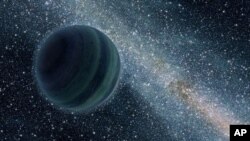Astronomers say the Milky Way may be swarming with nomad planets wandering through space instead of orbiting a host star, and that the galaxy may have a greater number of unmoored planets than stars.
Last year, astronomers detected about a dozen nomad planets wandering about the galaxy, using a technique called gravitational microlensing, in which the light of stars is momentarily refocused, and brightened, by the gravity of passing planets.
At that time, scientists estimated there could be two Jupiter-sized nomad planets for every typical star with orbiting planets in the Milky Way. Jupiter, a gas giant, is the largest planet in the solar system.
A new analysis by researchers at the Kavli Institute for Particle Astrophysics and Cosmology at Stanford University in California now estimates there could be 100,000 times more homeless planets than stars.
Louis Strigari, a research scientist at Kavli, led the study that calculated the gravitational pull of the Milky Way galaxy and the amount of cosmic matter, or material, available to form nomad planets.
"We imagined that the population of a dozen or so Jupiter-mass wandering or nomadic objects is just the tip of the iceberg relative to what’s really out there in terms of our galaxy," said Strigari. "So, if one makes assumptions about how many there are below the mass below Jupiter, then one can obtain a bound [an estimate] on how many of these actually exist.
While they might seem to be unlikely candidates for life as we know it, StrIgari says it is possible some of these wandering planets could harbor forms of bacterial life, even if they do not enjoy the heat of a sun.
“If the object has a thick enough atmosphere and say there’s tectonic activity or radioactivity going on, on the surface of the planet, the heat could get trapped by the thick atmosphere and could potentially be hospitable to microbial life,” said the research scientist.
Strigari also says there is a slight chance that two nomad planets could collide, flinging bacterial debris into other solar systems.
Astronomers hope to confirm the number of wandering planets in the next decade, when a newer generation of larger, more powerful telescopes - including the space-based Wide-Field Infrared Survey Telescope and the ground-based Large Synoptic Survey Telescope proposed by the U.S. space agency (NASA) - begins operating.
An article by Louis Strigari and colleagues on nomadic planets is published in the journal Monthly Notices of the Royal Astronomical Society.
